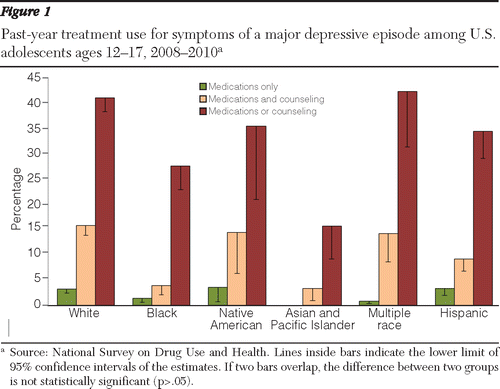Datapoints: Use of Medications and Counseling for Depression by Asian and Multiple-Race Adolescents Aged 12–17 Years
Asians and Pacific Islanders and multiple-race individuals are among the fastest growing U.S. populations (1). Asian, Hispanic, and black adults underuse mental health services for depression compared with whites (2,3), but less is known about treatment use among adolescents.
Adolescent samples from the National Survey on Drug Use and Health (NSDUH) (2008–2010) were pooled (N=54,161) (nsduhweb.rti.org). Estimates of treatment use were based on the subset of adolescents who met the NSDUH-defined criteria for a past-year DSM-IV major depressive episode (N=4,446). An adolescent was defined as having received treatment or counseling if he or she saw or talked to a medical doctor or other professional for depression, and medication treatment was defined as taking medications prescribed for depression in the past 12 months.
Overall, 37.0% of adolescents with a major depressive episode received any treatment for depression in the past year (2.8%, medications only; 21.7%, counseling only; and 12.5%, medications and counseling). No racial-ethnic differences were found in use of counseling only, but variations were noted for other categories (Figure 1). Use of any treatment was greater among whites (41.0%) than among blacks (27.5%) and Asians and Pacific Islanders (15.6%). Among whites the proportion using medications only (3.2%) was higher than among Asians and Pacific Islanders (<1%) and multiple-race adolescents (.8%). Use of medications and counseling was greater among whites (15.8%) than among blacks (3.9%), Asians and Pacific Islanders (3.3%), and Hispanics (9.1%).
This analysis reveals low rates of treatment use by Asians, Pacific Islanders, and blacks with major depression.
Study limitations include use of self-reports of depression and treatment use and a lack of information about number of treatment visits and type of medications used. Adolescents with fewer than five visits may not have received adequate care (3).
The findings highlight a need for research to elucidate low rates of treatment use and outcomes among minority groups with major depression.
1 : The Asian Population: 2010. Washington, DC, US Census Bureau, March 2012. Available at www.census.gov/prod/cen2010/briefs/c2010br-11.pdf Google Scholar
2 : Disparity in depression treatment among racial and ethnic minority populations in the United States. Psychiatric Services 59:1264–1272, 2008 Link, Google Scholar
3 : Retention in depression treatment among ethnic and racial minority groups in the United States. Depression and Anxiety 27:485–494, 2010 Crossref, Medline, Google Scholar
Figures and Tables

Figure 1 Past-year treatment use for symptoms of a major depressive episode among U.S. adolescents ages 12–17, 2008–2010



